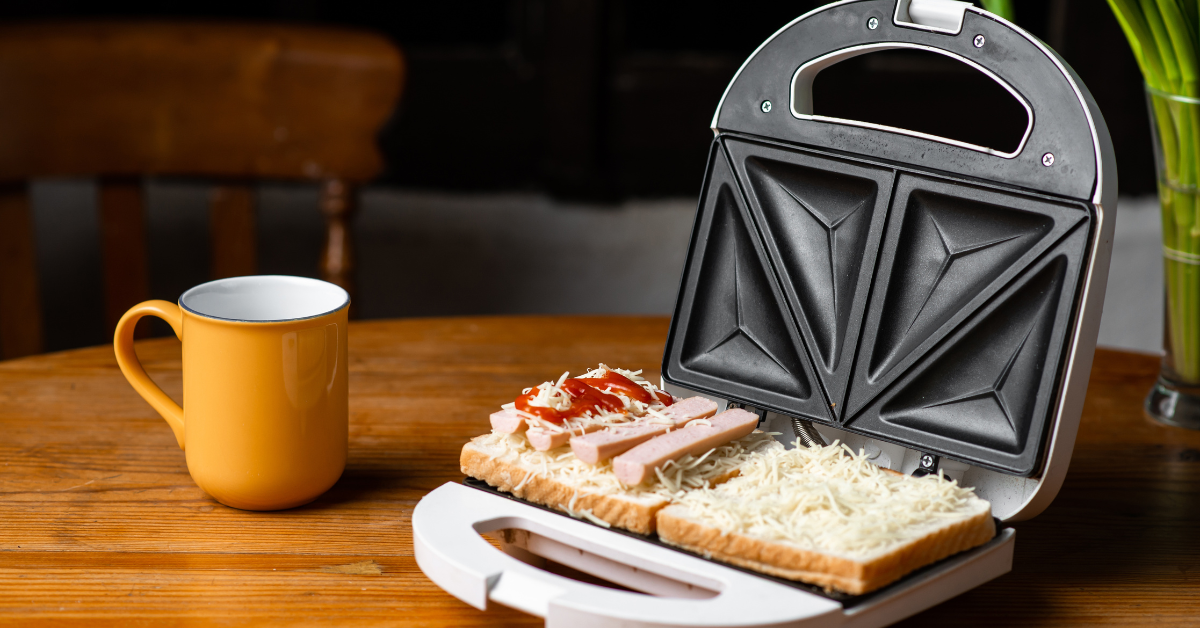In kitchens all over, people are using what’s called sandwich toasters or sandwich makers, and even panini presses, to make their toasted sandwiches fast and easy. Think of these little machines that can toast bread while heating up what’s inside your sandwich at the same time–providing you that crunchy bite and a nice hot middle.
Now, when it comes to using these or any device that needs to plug in, many people start to wonder about how much electricity it’s using. We’re going to delve into if sandwich toasters really do burn through a significant quotient of power — look into what affects how much energy they use — offer some advice on keeping your electric bill down — and include what to think about if you’re trying to be kind to the planet when you cook.
One, if they so decide, may ponder the question of whether using such a device is weighty on the environmental side and what it means for their wallet in terms of energy bill.
Understanding Sandwich Toasters
When you plug in a sandwich toaster and turn it on, the parts inside that heat up very quickly toast the bread and make the filling warm; the way they are built makes sure the heat goes everywhere evenly and cooks things fast; this is extremely handy for when you want to put together breakfast, a snack, or something light to eat, and you don’t have a significant amount of time; the concrete and clear culmination of this is a neatly toasted sandwich, ready to go in just a few minutes because of the spectacular design of the hinged plates with the heaters.
Electricity Consumption
The electricity consumption of sandwich toasters varies depending on several factors, including:
We turn to the topic of: how powerful these sandwich toasters can get – it’s absolutely undeniable that they’ve got some kick! Some can be as light on power as 600 watts–but you also have these beasts that crank it up to 1500 watts or even higher. Now, the more power they pack, the quicker they warm up and make that sandwich crunchy for you–but they’re going to use up a bit more electricity doing it.
You understand how, when you use a sandwich toaster, you only keep it on for a few minutes to heat up your items. Because it’s only running for that short bit of time, it doesn’t suck up as much power as other things in the house that have to stay on for hours; there is a clear and strong certainty that the quicker you toast your sandwich and turn off the appliance, the less electricity you’re going to use.
It’s focused on not letting it run longer than it needs to.
When you toast a large number of sandwiches, your electricity bill might see a small rise. However, this isn’t a major problem when you think about how much more energy items such as fridges and ovens use. Making a lot of toasted sandwiches doesn’t change things too much with your bills, because there are larger energy eaters at home.
And there can possibly be gratification in your knowing that using your sandwich toaster a lot isn’t making a huge change, especially given the appliances in your house that use a lot of energy.
Comparative Energy Use
In comparison to other kitchen appliances, sandwich toasters generally consume less electricity. For instance:
Let’s discuss how these kitchen gadgets use up electricity so you don’t get a big surprise when the bill comes. If we start with microwaves, they’re actually not too tough on your power because they’re only concerned with making food hot, fast, without needing a large amount of energy, like antiquated ovens. In regards to electric ovens, they use electricity very quickly: having a power level that can go from 1,000 watts to over 5,000 watts easily, especially if you’re the type to bake or roast for hours.
Now, about those kettles you use to get your water boiling for tea or hot chocolate; they’re sort of in the middle. They work with less power, around 1500 watts–but they still make your meter run while they heat up fast. Given all of this, a discerning reader, such as yourself, will surely comprehend the energy play each of these gadgets has in your kitchen and on your electricity use.
Tips for Energy Efficiency
To maximise energy efficiency when using a sandwich toaster, consider the following tips:
I consider choosing a sandwich toaster based on how much you eat is intelligent and informed. By doing this, you save energy because you don’t warm places you are not using. It’s key to unplug your sandwich toaster after using it because it uses power just sitting there, even when you’re not making anything; this trick keeps the electric bill low and saves energy.
Also, cleaning the toaster’s plates where you place your sandwich and its other parts regularly is extremely important. A discerning reader may begin to register these steps not only keep the machine working great but also be a vital part of saving on power use and keeping things safe.
If it becomes mixed up, it won’t heat your food right. And it’ll take more time and energy.
Preheat Efficiently: Those new special sandwich toasters heat up quickly. Don’t leave it running longer than you have to. Check what the people who made it say about how long it needs to get ready.
Use Timer Settings: If your toaster lets you, change the times for how long it’s on — definitely make things better with it, so you’re not cooking your items too much or leaving it on after you finish your snack.
Makes things easier and uses less energy. A discerning reader may begin to register that being intelligent and informed about how you use and take care of your sandwich toaster isn’t simply good for making snacks. It saves energy and prevents you from wasting money on extra power you’re not even using.
Environmental Considerations
Nowadays, everyone’s worried about being green and saving the planet, and that means we must know how much energy our items at home—even things as simple as sandwich toasters—are using. The good thing is, sandwich toasters aren’t really the perpetrators when it comes to energy; they don’t use a lot. But, if we start picking kitchen gadgets that care about the Earth just like we do and mix in some ways to use less power, we can lower the energy our houses use and be kind to Earth.
There is unsurprisingly a potential to do better for our planet just by looking into how much energy our kitchen items need–and making smarter choices.
Choosing Energy-Efficient Appliances
When you shop for spectacular sandwich-making gadgets for your kitchen, it’s intelligent and informed to check if they are Energy Star rated. Choosing these energy-saving appliances means your electric bill ends up being less – and that’s great because it reduces the awful material that goes into the air when we make electricity. This is very good for the planet.
Amazingly, these gadgets save energy but still work just as well as the normal ones. This path to understanding and wisdom shows that being thoughtful about what we buy can have great benefits.
Conclusion
One can see — unquestionably so — sandwich toasters stand out because they put together delicious, toasted sandwiches quickly and they’re easy on your electric bill; they only use small amounts of power to get the job done, so they’re not using lots of energy, unlike hefty kitchen gadgets including ovens or microwaves. In addition because they cook your treats in no time at all, these spectacular tools are extremely handy and leave no room for doubt on their efficiency.
Now, if you think about how much energy they use, try to use them in an intelligent and informed manner that doesn’t harm the planet too much — we can keep making our favorite toasted sandwiches without feeling bad about creating a large energy problem at home. They’re solid for putting together amazing meals and snacks extremely quickly, and without a significant amount of fuss, whether you’re someone who uses them now and then, or essentially all the time.
If we’re into keeping our planet green while still eating tasty toasted sandwiches, thinking scrupulously about how we use our sandwich toasters, and opting to cook in ways that don’t eat up a significant amount of power, is the way to go.




